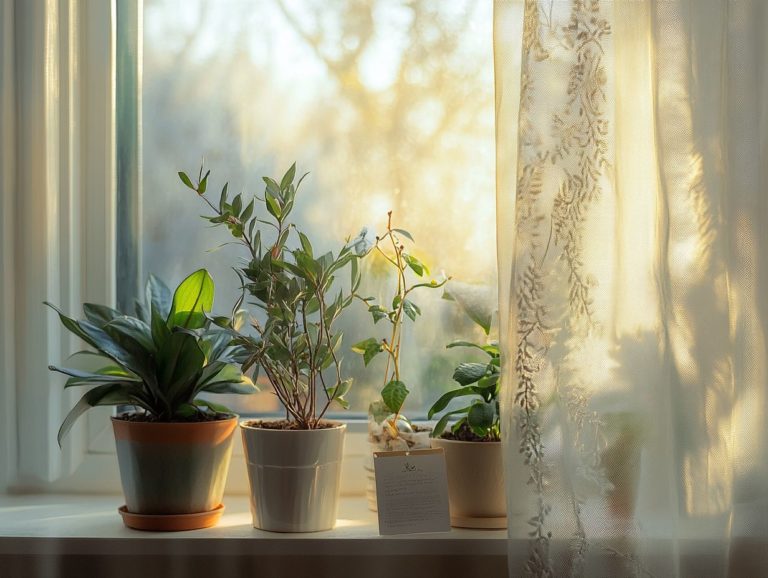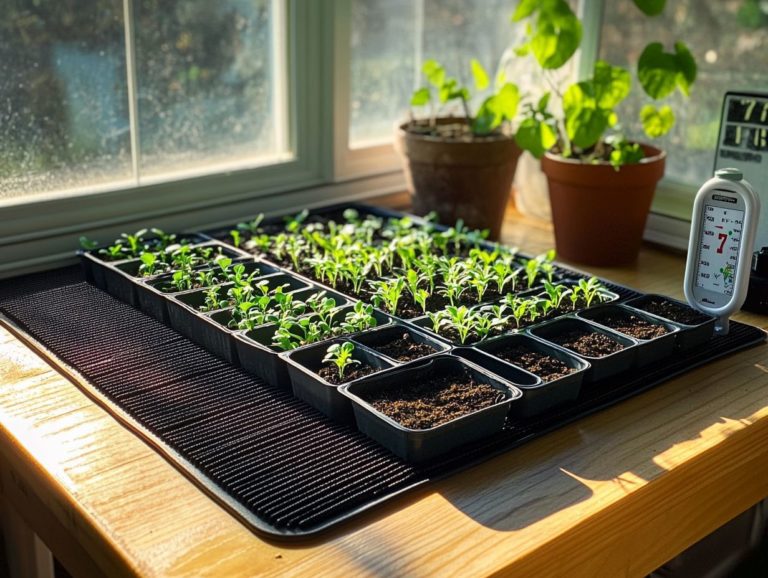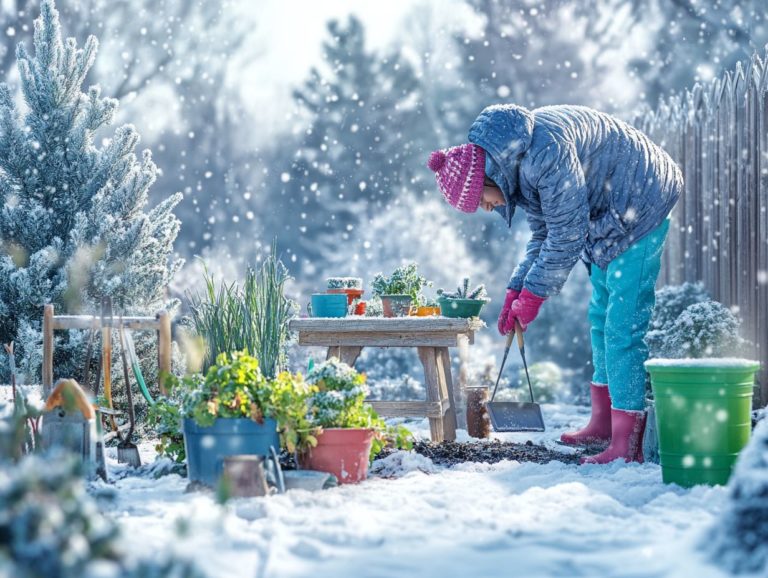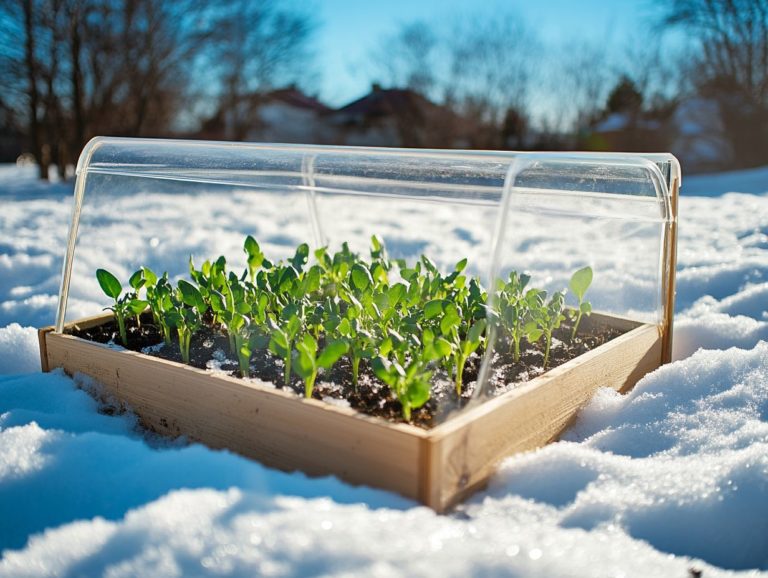DIY Winter Gardening Projects for Home
Don t let the winter chill intimidate you! Dive into winter gardening for a rewarding experience. Winter gardening presents a treasure trove of benefits and opportunities for those eager to keep their hands in the soil, even as the temperatures dip.
You can cultivate plants that can survive cold weather and engage in creative DIY projects, such as building a winter greenhouse. This guide is designed to help you navigate the unique challenges of gardening during the colder months.
Explore tips for maintaining your winter garden, protecting your plants, and enjoying a bountiful harvest that can brighten even the frostiest of days.
Embrace the beauty and potential of winter gardening, and transform your outdoor space into a thriving winter haven.
Contents
- Key Takeaways:
- Choosing the Right Plants for Winter Gardening
- Benefits of Winter Gardening
- DIY Winter Gardening Projects
- Tips for Maintaining a Winter Garden
- Harvesting and Using Winter Garden Produce
- Frequently Asked Questions
- What are some easy DIY winter gardening projects for home?
- What steps do I follow to create a winter vegetable garden?
- What materials do I need to build a greenhouse for my winter gardening projects?
- Can I use recycled materials for my DIY winter gardening projects?
- What type of plants can I grow in a winter container garden?
- How do I protect my plants from winter frost and cold temperatures?
Key Takeaways:

- Unlock the secrets of winter gardening for fresh produce and better mental health!
- Try cold-tolerant plants like kale and Brussels sprouts for a nutritious winter harvest!
- Keep busy and creative with fun DIY winter gardening projects!
Choosing the Right Plants for Winter Gardening
Choosing the right plants for winter gardening is essential for securing a fruitful harvest. It s particularly important to focus on cold-tolerant varieties, such as bare-root plants, rhubarb, and robust herbs that thrive even in the chill of winter.
Benefits of Winter Gardening
Winter gardening opens up a world of exciting benefits! This practice enables you to grow vegetables and herbs even during the chillier months. Embracing this practice not only yields fresh produce but also enriches your garden s biodiversity by drawing in birds and beneficial wildlife.
It also makes excellent use of your gardening tools and resources, promoting sustainable practices like composting. By diving into various garden ideas like installing birdhouses or engaging in seed swaps, you can turn your outdoor space into a flourishing winter haven. For tips on overcoming winter gardening challenges, engaging in workshops and community events can elevate your gardening experience to new heights.
Why Garden in the Winter?
Gardening in the winter allows you to harness the unique growing conditions of the season, making it an ideal opportunity to cultivate specific vegetables while optimizing your gardening tools and techniques.
This practice offers several advantages, including extended growing seasons that let you enjoy fresh produce well beyond the traditional harvest months. The cooler weather also helps to mitigate pest problems since many insects are less active or entirely absent during this time.
Utilizing raised beds and other gardening tools becomes particularly effective in winter, providing better drainage and protecting your plants from harsh weather. For instance, leafy greens like kale, spinach, and Swiss chard thrive in colder temperatures, making them perfect candidates for your winter gardening endeavors, especially when utilizing vertical gardening in winter.
By adapting your methods and leveraging these unique advantages, you can ensure that your garden flourishes even amidst the chill of winter.
Cold-Tolerant Plants and Their Benefits
Cold-tolerant plants are vital for your winter gardening success. They don t just survive; they thrive, providing you with fresh vegetables, microgreens, and herbs even during the chillier months.
Kale and spinach are among the top contenders, capable of enduring frost and actually improving in flavor after a freeze. Not only are they resilient, but they also pack a flavorful punch. Many herbs, such as parsley, cilantro, and thyme, boast impressive cold tolerance, allowing you to savor vibrant flavors all year round.
These hardy plants not only sustain you during winter but also enhance your nutrition, as they tend to be richer in vitamins when grown in cooler temperatures. By incorporating these varieties into your winter garden, you can relish the satisfaction of ongoing harvests throughout the season, showcasing the incredible possibilities of year-round gardening.
What are you waiting for? Grab your gardening tools and start planting today!
DIY Winter Gardening Projects

Engaging in DIY winter gardening projects can elevate your gardening experience. You’ll have the opportunity to craft structures such as greenhouses and raised beds, or make effective use of plant pots and grow lights. To enhance your efforts, check out this guide on how to create a winter gardening toolkit to ensure your plants thrive beautifully.
Creating a Winter Greenhouse
Creating a winter greenhouse is a brilliant way to extend your growing season. It offers a place where you control the conditions for nurturing vegetables and herbs, even in the depths of winter.
With thoughtful planning, you can craft a thriving space that is not only functional but also a pleasure to maintain. Start by selecting the perfect location look for a spot that basks in ample sunlight while being shielded from harsh winter winds.
For construction, consider using clear polycarbonate panels (clear plastic that keeps heat in) or polyethylene film, as both materials excel at retaining heat.
When designing your greenhouse, think about the optimal height and ventilation systems. These elements are key for promoting air circulation, which is vital for your plants’ health. Using plant pots enhances drainage and simplifies soil management. Incorporating grow lights can elevate photosynthesis, especially during dreary overcast days, allowing your plants to thrive despite the frosty conditions outside.
Building a Raised Bed for Winter Gardening
Building raised beds for winter gardening enhances soil drainage and aeration. It also creates a more organized and efficient gardening experience, ideal for cultivating winter vegetables.
You can construct these elevated structures using a variety of materials like untreated wood, stone, or even recycled plastic. This allows you to customize them to match your backyard aesthetic perfectly. The design can vary according to your personal style and available space, whether you choose a single rectangular bed or a series of interconnected plots.
When deciding where to place your raised beds, ensure they receive ample sunlight to warm the soil, promoting growth even in colder months. The benefits of raised beds include improved soil warmth, as they heat up more quickly in the sun. Their height provides easier access for planting and maintaining crops, reducing strain on your back and knees during chilly gardening sessions.
Indoor Gardening Ideas for Winter
Start an indoor herb garden or sprout seeds for fresh flavors even in winter! This strategy allows you to enjoy vibrant greens when the weather outside is less than inviting.
Using grow lights can elevate your indoor gardening experience, providing the perfect light spectrum for optimal plant growth. Explore a delightful array of herbs such as basil, mint, and cilantro each thriving under the right conditions of light and care.
If you’re looking for a rewarding option, consider growing microgreens. They require minimal space and offer a swift journey from seed to harvest.
To maintain a pristine and healthy environment for your indoor plants, regular cleaning of pots is essential. This practice helps prevent mold and pests. Keep your growing area organized and ensure proper ventilation to contribute to the longevity of your herbs and microgreens. This makes your indoor gardening experience successful and fulfilling.
Tips for Maintaining a Winter Garden
Maintaining a winter garden demands meticulous attention to detail. Protect your plants from frost and heavy snow. Make sure they get enough water and fertilizer to encourage robust growth.
Each aspect plays a vital role in the overall health of your garden, requiring your careful consideration and expertise.
Protecting Plants from Frost and Snow
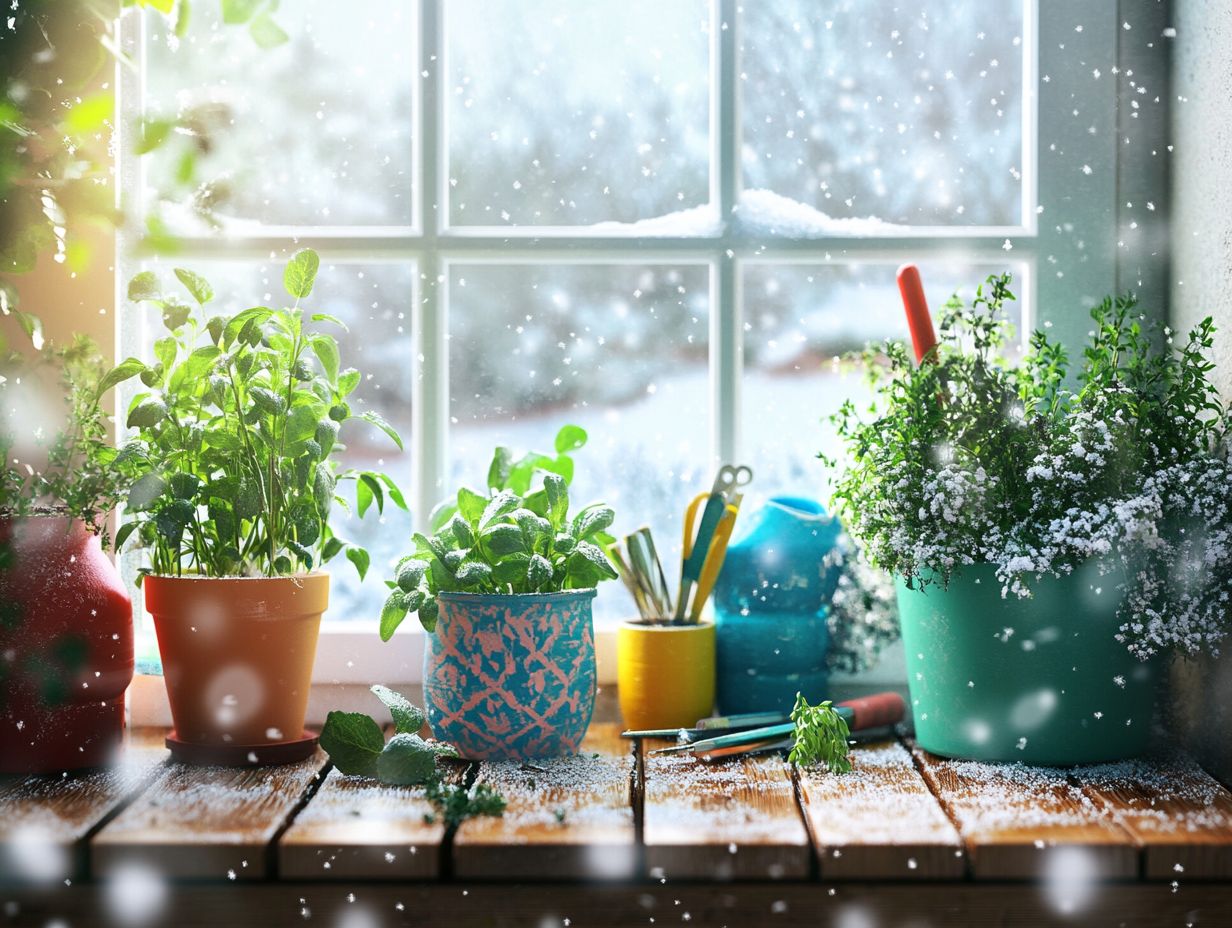
Protecting your plants from frost and snow is essential for successful winter gardening. You’ll want to employ specific techniques to keep your potted plants and garden paths healthy and thriving.
Using protective covers creates a strong barrier against winter s harsh elements, retaining moisture while shielding delicate foliage from biting winds.
Consider placing your plant pots in sheltered spots, like near walls or larger shrubs. This significantly decreases their exposure to cold drafts and shifting snow.
Creating clear pathways is another smart move; it minimizes foot traffic and prevents compacted snow from accumulating around the roots. With these simple strategies, you can create a thriving winter garden that dazzles!
Watering and Fertilizing in the Winter
Effective watering and fertilizing in winter gardening is crucial for your plants’ health. Adjust your techniques and tools to adapt to the colder temperatures.
To ensure your plants thrive during these chillier months, closely monitor soil moisture levels. Evaporation rates plummet in winter. A moisture meter a tool that helps check how wet the soil is can be your best ally, helping you avoid overwatering, especially important when roots are more vulnerable to rot.
Incorporating natural fertilizers from your compost bin a container where you can recycle organic waste into nutrient-rich soil offers a sustainable boost to soil nutrients without resorting to synthetic options.
When the frost rolls in, having insulated watering cans and frost-resistant gardening gloves at your disposal will simplify the process, making it easier to nurture your winter gardens.
Harvesting and Using Winter Garden Produce
To effectively harvest and utilize winter garden produce, it is essential to grasp the best practices for timing and techniques, especially for crops like rhubarb and other cold-tolerant vegetables.
Understanding these nuances will elevate your gardening experience and ensure you make the most of your seasonal bounty.
Best Practices for Harvesting and Storing Winter Produce
Implementing best practices for harvesting and storing winter produce is essential for maximizing both freshness and flavor. By using the right gardening tools and techniques, you can ensure the highest quality.
Harvesting methods change with each vegetable type be it kale, carrots, or Brussels sprouts and each requires a tailored approach to preserve its distinct flavors.
Once you’ve harvested carefully, use appropriate storage solutions, like breathable bags or sealed containers, to maintain freshness for several weeks.
Incorporating a compost bin into your gardening routine enriches the soil for future crops and reduces landfill output, making your gardening practice more sustainable.
By following these practices, you ll ensure that your winter garden thrives, yielding healthy and vibrant produce throughout the season.
Frequently Asked Questions
What are some easy DIY winter gardening projects for home?
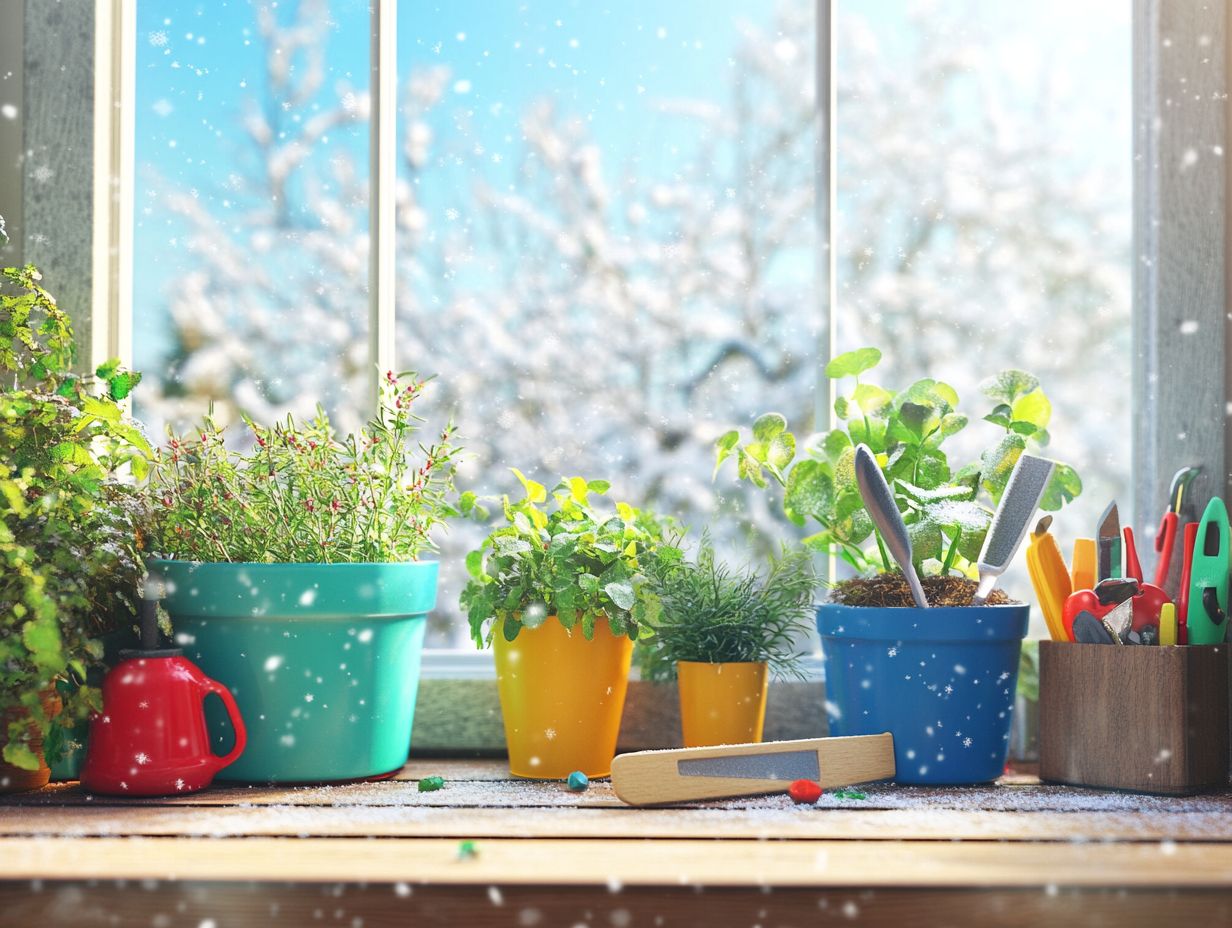
Some easy DIY winter gardening projects include creating a winter vegetable garden, building a greenhouse, and making your own cold-weather gardening tools.
What steps do I follow to create a winter vegetable garden?
You can create a winter vegetable garden by using cold-hardy plants, such as kale, Brussels sprouts, and garlic, and protecting them with a layer of mulch or a cold frame.
What materials do I need to build a greenhouse for my winter gardening projects?
You will need materials such as PVC pipes, plastic sheeting, and basic tools like a saw and drill to build a simple greenhouse for your winter gardening projects. Consider gathering essential winter gardening supplies to ensure your success.
Can I use recycled materials for my DIY winter gardening projects?
Yes, you can use recycled materials for your DIY winter gardening projects. For example, old plastic containers can be repurposed as seed starter pots or planters, and you can learn more about this by checking out how to start your winter gardening early.
What type of plants can I grow in a winter container garden?
You can grow many plants in a winter container garden. Consider evergreen shrubs, hardy herbs like rosemary and thyme, and winter-blooming flowers such as pansies and hellebores.
How do I protect my plants from winter frost and cold temperatures?
Keep your winter plants safe from frost and cold. Use protective covers like cloches and fleece blankets.
You can also bring potted plants indoors or into a greenhouse for extra warmth.
Start your winter garden today for a vibrant touch to your home!

